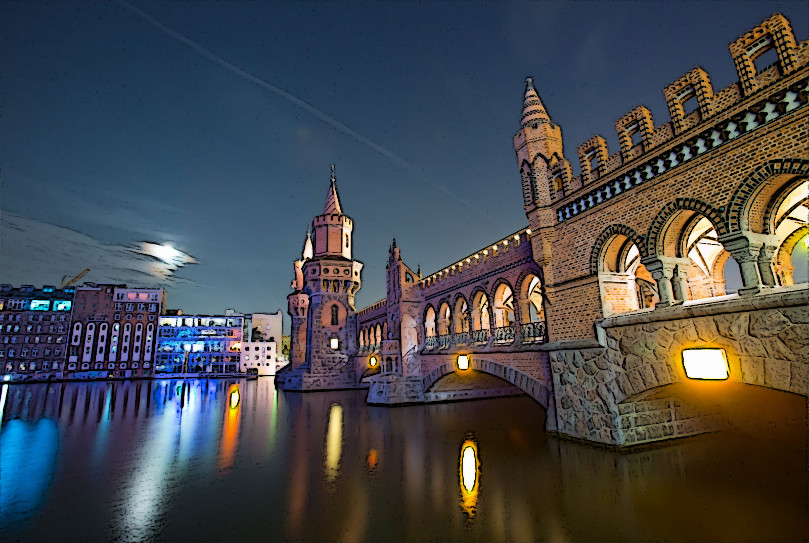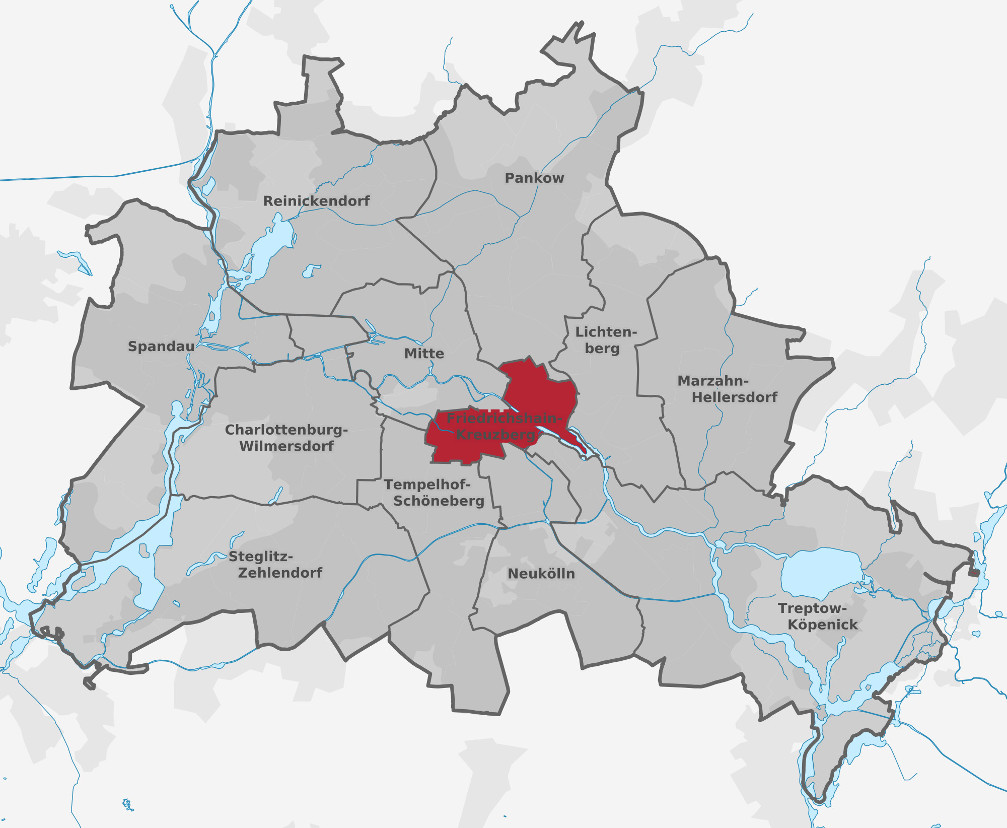Friedrichshain: Difference between revisions
| Line 19: | Line 19: | ||
== History == | == History == | ||
The largely working-class district was created in 1920 when Greater Berlin was established by referendum, incorporating several surrounding settlements. Friedrichshain united the Frankfurter Vorstadt, already part of Berlin, and the villages of Boxhagen and Stralau. It took its name (meaning 'Frederick's Grove') from the Volkspark ('People's Park'), which was planned in 1840 to commemorate the centenary of Frederick the Great’s coronation. Much of the district was settled in the rapid industrialization of the 19th and early 20th centuries, led by growth in manufacturing and crafts. It owed much to the opening of the railway line between Berlin and Frankfurt (Oder) in 1846 (which terminated near the site of today's Berlin Ostbahnhof), and the opening of the first waterworks in 1865 at Stralauer Tor. In 1874 the Krankenhaus im Friedrichshain was opened, Berlin's first hospital beside the university clinic Charité. In the early 1900s, the district's largest employer was the Knorr-Bremse brake factory; the Knorrpromenade, one of Friedrichshain's most attractive streets, was built to house the management. The street network of Friedrichhain was originally specified in the Hobrecht-Plan and the area was part of what came to be known architecturally as the Wilhelmine Ring. | |||
When the Nazis came to power in 1933, the district was renamed Horst-Wessel-Stadt after the Nazi activist and writer of the Nazi hymn whose slow death, after being shot by communists, in Friedrichshain hospital in 1930 was turned into a propaganda event by Joseph Goebbels. | |||
During World War II Friedrichshain was one of the most badly damaged parts of Berlin, as Allied strategic bombers specifically targeted its industries. As late as the nineties, some buildings still displayed bullet holes from the intense house to house fighting during the Battle of Berlin. After the war ended, the boundary between the US and Soviet occupation sectors ran between Friedrichshain and Kreuzberg, with Friedrichshain in the east and Kreuzberg in the west. This became a sealed border between East and West Berlin when the Berlin Wall was built in 1961. | |||
Stalinallee (previously Große Frankfurter Straße) was built in Friedrichshain in the late 1940s and early 1950s as a prestige project; the architecture of its 'workers' palaces' is strongly reminiscent of the ostentatious Soviet-era Moscow boulevards and is sometimes mockingly described as Zuckerbäckerstil ('wedding cake style'). The 1953 uprising had its origins in these construction projects, as increased work quotas led to protests that soon spread throughout East Germany, and were only put down by armed Soviet intervention. | |||
In the period of De-Stalinization following the Soviet leader's death, the boulevard was renamed Karl-Marx-Allee at one end and Frankfurter Allee at the other. From this time onwards, Friedrichshain often featured on East Berlin's cultural map: in 1962 the Kosmos, East Germany's largest cinema, was opened, followed in 1981 by the country's most ambitious swimming and sports complex, the Sport- und Erholungszentrum. Neither of these buildings serve their original function today. | |||
== Culture == | == Culture == | ||
Revision as of 17:54, 4 July 2016
Pronunciation
(Frl-Drrik-ShAYn)
Location
Description
Friedrichshain is a district of Berlin, Germany. From its creation in 1920 until 2001, it was a freestanding city borough. Formerly part of East Berlin, it is adjacent to Mitte, Prenzlauer Berg, Kreuzberg and Lichtenberg.
Friedrichshain is named after the Volkspark Friedrichshain, a vast green park at the northern border with Prenzlauer Berg. In the Nazi era, the borough was called Horst-Wessel-Stadt. Friedrichshain is one of the trendy districts of Berlin and has experienced gentrification.
Population
2009 Census = 114,050
History
The largely working-class district was created in 1920 when Greater Berlin was established by referendum, incorporating several surrounding settlements. Friedrichshain united the Frankfurter Vorstadt, already part of Berlin, and the villages of Boxhagen and Stralau. It took its name (meaning 'Frederick's Grove') from the Volkspark ('People's Park'), which was planned in 1840 to commemorate the centenary of Frederick the Great’s coronation. Much of the district was settled in the rapid industrialization of the 19th and early 20th centuries, led by growth in manufacturing and crafts. It owed much to the opening of the railway line between Berlin and Frankfurt (Oder) in 1846 (which terminated near the site of today's Berlin Ostbahnhof), and the opening of the first waterworks in 1865 at Stralauer Tor. In 1874 the Krankenhaus im Friedrichshain was opened, Berlin's first hospital beside the university clinic Charité. In the early 1900s, the district's largest employer was the Knorr-Bremse brake factory; the Knorrpromenade, one of Friedrichshain's most attractive streets, was built to house the management. The street network of Friedrichhain was originally specified in the Hobrecht-Plan and the area was part of what came to be known architecturally as the Wilhelmine Ring.
When the Nazis came to power in 1933, the district was renamed Horst-Wessel-Stadt after the Nazi activist and writer of the Nazi hymn whose slow death, after being shot by communists, in Friedrichshain hospital in 1930 was turned into a propaganda event by Joseph Goebbels.
During World War II Friedrichshain was one of the most badly damaged parts of Berlin, as Allied strategic bombers specifically targeted its industries. As late as the nineties, some buildings still displayed bullet holes from the intense house to house fighting during the Battle of Berlin. After the war ended, the boundary between the US and Soviet occupation sectors ran between Friedrichshain and Kreuzberg, with Friedrichshain in the east and Kreuzberg in the west. This became a sealed border between East and West Berlin when the Berlin Wall was built in 1961.
Stalinallee (previously Große Frankfurter Straße) was built in Friedrichshain in the late 1940s and early 1950s as a prestige project; the architecture of its 'workers' palaces' is strongly reminiscent of the ostentatious Soviet-era Moscow boulevards and is sometimes mockingly described as Zuckerbäckerstil ('wedding cake style'). The 1953 uprising had its origins in these construction projects, as increased work quotas led to protests that soon spread throughout East Germany, and were only put down by armed Soviet intervention.
In the period of De-Stalinization following the Soviet leader's death, the boulevard was renamed Karl-Marx-Allee at one end and Frankfurter Allee at the other. From this time onwards, Friedrichshain often featured on East Berlin's cultural map: in 1962 the Kosmos, East Germany's largest cinema, was opened, followed in 1981 by the country's most ambitious swimming and sports complex, the Sport- und Erholungszentrum. Neither of these buildings serve their original function today.
Culture
Burgomeister
- -- Stefan Rutigar -- Burgomeister

